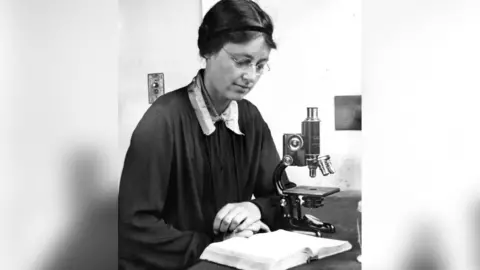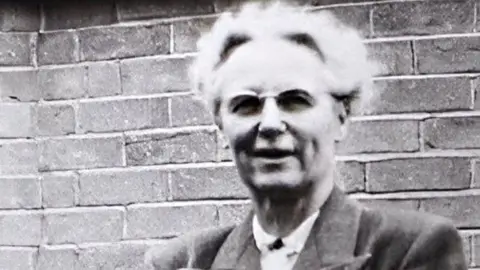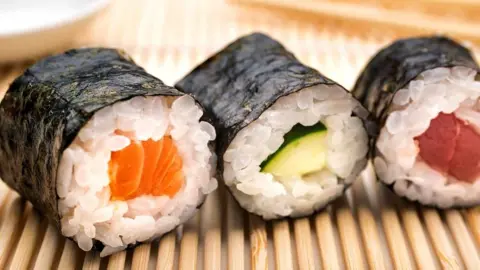Enjoy sushi? You may have Welsh seaweed to thank for it
 Smithsonian Institution
Smithsonian InstitutionIf you are one of the increasing number of Brits who now tuck in to a portion of sushi for lunch rather than a traditional sandwich, spare a thought for Welsh seaweed.
Because if it were not for the algae known as laver growing on the north Welsh coastline, it is very likely the sushi industry as we know it today would not exist.
And it is all thanks to the remarkable work of a British scientist who began her studies over a century ago and is now revered as an almost goddess-like figure in Japan, a country she never set foot in.
Kathleen Drew was a woman very much in the vanguard of female education.
Born in Leigh, Greater Manchester, she was a hardworking young girl who won a scholarship to study botany at the University of Manchester, where she graduated with first class honours in 1922 and took a master's degree the following year.
She began work as a researcher at the university, where she specialised in coastal botany, and seaweeds in particular.
In 1925 she earned a two-year fellowship to study at the University of California, Berkeley, and saw places as far afield as Hawaii in the course of her research.
 Manchester University
Manchester UniversityBut it was to prove to be work done later in her life and much, much closer to home, during a trip to north Wales, that Kathleen would make her revolutionary discovery, which was to have such profound and positive consequences for Japanese coastal workers half a world away.
The remarkable thing about Kathleen was her devotion to her subject. She married a fellow academic in 1928, becoming Kathleen Drew-Baker and, in line with practices at the time, could no longer be employed by the university as a married woman.
But she retained an honorary position for the rest of her life, even though it meant working for free.
A University of Manchester spokesperson said: "Sadly, her work was all unpaid – she became a research fellow, and she worked mostly at home, as well as sometimes at the university.
"They lived on her husband's wage - she collected her specimens in old jam jars, and he helped her to build a tidal tank in her unfunded laboratory."
 Deborah Tilley/Geograph
Deborah Tilley/GeographIn 1949, Kathleen went on that fateful trip, which according to social anthropologist Kaori O'Connon, was to Rhosneigr, Anglesey, as documented in her book Seaweed: A Global History.
She went out onto the shore and gathered a handful of porphyra – the same seaweed used to make the Welsh delicacy laverbread – and took it back to her laboratory, where she put it into salt water and let it release spores and put the spores into another dish.
But the critical point was the she also placed some shell into the dish. The spores moved into the shell, from where they started covering the shell in a red substance.
This was the eureka moment for Kathleen, who realised that the red she could see was algae known as Conchocelis rosea. Scientists had always believed it to be a species in its own right – now she could clearly see that they were in fact one and the same organism, and that this was an intermediate phase of its development.
She published her findings in the respected journal Nature, just 100 lines of text. But they were to prove transformative once they were read by a fellow botanist in Japan.
 Getty Images
Getty ImagesLaver is essentially the same type of seaweed as one known as nori in Japan. For those lunchtime sushi eaters, you will know it as the black substance used to bind the parcels of rice and seafood together. It's at the heart of the dish.
But although nori had been produced in Japan for centuries, it was in steep decline. It is known as "lucky grass" there because you are considered lucky if you can produce it – it appears to disappear between one round of crops and the next without "seeds", making it a risky and difficult item to rely on. Pollution and other factors such as typhoons had severely impacted its growth, and a post-war population was in desperate need of reliable food sources.
What Kathleen's discovery showed was that the nori did not disappear but was in fact Conchocelis rosea, and what it needed to be kept in regular production was a "home" for this intermediate stage, rather than allowing these spores to drift out to sea. This can be done by providing shells attached to vast nets for the spores to nest in.
Nori production is now a multi-billion pound industry. Most Japanese people eat some form of nori every day, underscoring its importance to their diet and the economy.
And further afield, sushi restaurants and outlets abound across the UK and other countries. It's even the most popular product in a premium Tesco meal deal these days.
 Simasakon/Wikimedia Commons
Simasakon/Wikimedia CommonsThe sea farmers of Uto, on the southwest coast of Japan, nearly 6,000 miles from the Welsh waters where Kathleen gathered her laver, were so thankful to this Western woman they built a statue of her in the city.
Every year since 1963, six years after her death, they hold a ceremony on 14 April led by Shinto priests to honour her memory and her legacy, attended not just by growers but by people from all over Japan.
This date has been named National Laverbread Day in Wales in Kathleen's honour to celebrate the Welsh seaweed that inspired her findings.
The hilltop shrine just west of the city of Uto overlooks the water, where thousands of stakes out at sea mark the places nori is grown and harvested.
Kathleen is referred to respectfully in Japanese as "onjin", which means a benefactor or a person you are indebted to.
But she has been given another title. In a country where the sea is already revered as being central to its society, history and culture – the Japanese kanji [writing] symbol for sea is made up of three elements representing water, mother and everyone – Kathleen has been named Mother of the Sea.
Mother of everyone.
